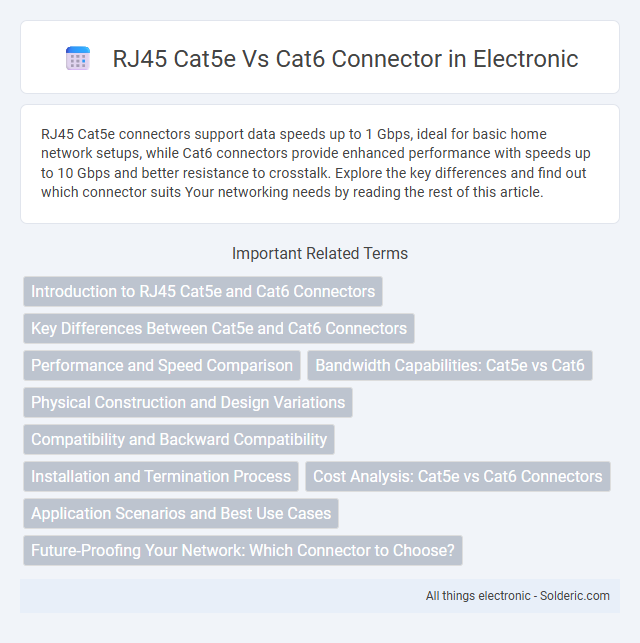RJ45 Cat5e connectors support data speeds up to 1 Gbps, ideal for basic home network setups, while Cat6 connectors provide enhanced performance with speeds up to 10 Gbps and better resistance to crosstalk. Explore the key differences and find out which connector suits Your networking needs by reading the rest of this article.
Comparison Table
| Feature | RJ45 Cat5e | RJ45 Cat6 |
|---|---|---|
| Maximum Data Rate | 1 Gbps | 10 Gbps |
| Maximum Frequency | 100 MHz | 250 MHz |
| Cable Type | Unshielded Twisted Pair (UTP) or Shielded (STP) | Shielded (STP) or UTP with better insulation |
| Maximum Cable Length | 100 meters | 55 meters for 10 Gbps, up to 100 meters for lower speeds |
| Use Case | Standard Ethernet Networks, Home, Small Office | High-Speed LAN, Data Centers, Professional Networks |
| Performance | Supports up to Gigabit Ethernet | Supports up to 10 Gigabit Ethernet |
| Price | Lower | Higher |
Introduction to RJ45 Cat5e and Cat6 Connectors
RJ45 Cat5e and Cat6 connectors are essential components in Ethernet networking, designed to terminate twisted pair cables and enable reliable data transmission. Cat5e connectors support speeds up to 1 Gbps and frequencies up to 100 MHz, while Cat6 connectors provide enhanced performance with speeds up to 10 Gbps and frequencies up to 250 MHz, making them suitable for higher bandwidth applications. Both connectors maintain compatibility with standard RJ45 ports, ensuring ease of installation and backward compatibility within network infrastructures.
Key Differences Between Cat5e and Cat6 Connectors
Cat5e and Cat6 connectors differ primarily in their design specifications to support higher data transmission speeds and reduced crosstalk. Cat6 connectors feature tighter twists and thicker insulation, allowing you to achieve speeds up to 10 Gbps over shorter distances, compared to 1 Gbps with Cat5e. Your choice impacts network performance, especially in environments requiring higher bandwidth and improved signal integrity.
Performance and Speed Comparison
RJ45 Cat6 connectors support higher transmission speeds up to 10 Gbps at 55 meters, outperforming Cat5e connectors which typically handle 1 Gbps at 100 meters. Cat6 connectors offer improved performance with reduced crosstalk and higher frequency bandwidth of 250 MHz compared to Cat5e's 100 MHz, ensuring more reliable and faster data connections. Choosing a Cat6 connector boosts your network's capacity to handle demanding applications and future-proofs your infrastructure for faster internet speeds.
Bandwidth Capabilities: Cat5e vs Cat6
Cat5e connectors support bandwidths up to 100 MHz, suitable for standard Gigabit Ethernet applications, while Cat6 connectors provide enhanced performance with bandwidth capabilities up to 250 MHz, enabling faster data transmission and reduced crosstalk. The higher frequency rating of Cat6 allows for improved network reliability and supports 10 Gigabit Ethernet over shorter distances. Choosing Cat6 connectors enhances network speed and efficiency in environments demanding high-performance connectivity.
Physical Construction and Design Variations
RJ45 Cat5e connectors feature a simpler physical construction with thinner wires and less stringent twisting compared to Cat6, allowing for speeds up to 1 Gbps over 100 meters. Cat6 connectors have improved design variations, including thicker insulation, tighter twists, and separated pairs to reduce crosstalk and support speeds up to 10 Gbps over shorter distances. The enhanced physical design of Cat6 connectors often includes molded connectors for better performance and durability in high-frequency data transmissions.
Compatibility and Backward Compatibility
RJ45 Cat5e connectors are fully compatible with Cat6 cables and support data transmission speeds up to 1 Gbps, making them suitable for most standard network setups. Cat6 connectors, designed to handle higher frequencies up to 250 MHz, support speeds up to 10 Gbps over shorter distances and maintain backward compatibility with Cat5e and Cat5 cables. Both connector types ensure seamless integration across network devices, but Cat6 connectors provide enhanced performance for higher bandwidth applications while preserving interoperability with lower-category hardware.
Installation and Termination Process
RJ45 Cat5e connectors typically have a simpler installation and termination process, requiring standard tools and less precision due to their lower performance specifications, making them suitable for basic networking needs. Cat6 connectors demand more careful wire organization and precise termination techniques to ensure they meet higher frequency standards and reduce crosstalk, which often involves using tools designed for tighter tolerances. Your choice between Cat5e and Cat6 connectors will impact the complexity of installation and the reliability of your network's performance.
Cost Analysis: Cat5e vs Cat6 Connectors
Cat5e connectors are generally more cost-effective than Cat6 connectors, making them a budget-friendly choice for basic networking needs. Cat6 connectors, while slightly more expensive, support higher data transfer speeds and improved performance for future-proofing your network. Your decision should balance immediate costs against long-term performance benefits, especially for high-bandwidth applications.
Application Scenarios and Best Use Cases
RJ45 Cat5e connectors are ideal for standard Ethernet networks supporting speeds up to 1 Gbps, commonly used in residential and small office setups for internet browsing and streaming. Cat6 connectors, supporting speeds up to 10 Gbps over shorter distances, excel in data centers, enterprise networks, and environments requiring high-bandwidth applications like video conferencing and large file transfers. Choosing Cat6 is optimal for future-proofing networks demanding higher performance and reduced crosstalk in professional or high-density settings.
Future-Proofing Your Network: Which Connector to Choose?
Choosing a Cat6 RJ45 connector over Cat5e significantly enhances network future-proofing by supporting higher data transfer rates up to 10 Gbps and reducing crosstalk with improved shielding. Cat6 connectors provide better performance for gigabit Ethernet and are ideal for environments anticipating increased bandwidth demands due to streaming, gaming, or cloud services. Investing in Cat6 technology ensures compatibility with emerging applications and extends the lifespan of your network infrastructure.
RJ45 Cat5e vs Cat6 connector Infographic

 solderic.com
solderic.com